June 5, 2009
Air Date: June 5, 2009
FULL SHOW
SEGMENTS
Defending BPA
View the page for this story
Bisphenol-A has an image problem. The chemical, known as BPA, has been linked to health problems ranging from cancer to obesity. But as lawmakers from Capitol Hill to California consider banning BPA in some products, industries that use it to line the cans of food and beverages are mounting a campaign to persuade the public that BPA is safe. Lyndsey Layton, staff writer for the Washington Post, talks with host Steve Curwood about the private, strategic meeting industry executives held to defend BPA. (06:00)
The End of the Road
View the page for this story
Our national forests will continue to be less traveled, at least for another year. President Obama recently declared a one year moratorium on building new roads in national forests. Host Bruce Gellerman asks Mike Anderson, a senior resources analyst with the Wilderness Society in Seattle, how halting the roadless ruling will affect the nation’s wilderness. (05:50)
Tribal Representatives Speak out About UN Forest Proposal
/ Bruce GellermanView the page for this story
Representatives of indigenous groups from more than 70 countries meet at the United Nations in New York City. Top on their agenda is how a United Nations mechanism to reduce deforestation will affect native communities. Host Bruce Gellerman reports that the groups who depend most on intact forests might actually suffer from an international mechanism to preserve them. (09:15)
Growing Hope in New Orleans
View the page for this story
Sunflowers are bringing new life to blighted neighborhoods of New Orleans. Will Bradshaw of Green Coast Enterprises tells host Steve Curwood that Project Sprout’s test plot of sunflowers will not only remove heavy metals from the contaminated soil, the flower seeds will also be made into biofuel. (05:10)
Everybody Eats
/ Mark Seth LenderView the page for this story
Salt Marsh Diary writer Mark Seth Lender puts on the feed for all his feathered customers, dawn to dusk! (03:00)
Discovering Walruses
/ Matthew BrunwasserView the page for this story
Not much is known about the walrus since the animals inhabit some of Earth’s most remote places. But researchers are beginning to observe some remarkable things about walrus behavior: not only are they very musical, but they are also very gregarious and sexual. Matthew Brunwasser reports. (08:15)
Cycling to the Bottom of the World
View the page for this story
Some folks travel to the world’s highest mountaintops. But Jim Malusa decided to do the opposite. Over a period of six years, Malusa biked his way to the lowest points on the face of the planet. Jim Malusa chronicles his adventures in the book, “Into Thick Air: Biking to the Bellybutton of Six Continents” and spoke with host Bruce Gellerman about pedaling to, what he calls, the “anti-summits” of the world. (07:25)
This week's EarthEar selection
listen /
download
Clear-cutting the forest in the Sierra Nevada mountains dramatically changed the ecosystem. Listen to recordings of Lincoln Meadow in 1989 before it was logged, and then afterwards, 18 years later.
Show Credits and Funders
Show Transcript
Hosts: Steve Curwood and Bruce Gellerman
Guests: Michael Anderson,Will Bradshaw, Lyndsey Layton, Jim Malusa
Reporters: Matthew Brunwasser. Bruce Gellerman
Commentator: Mark Seth Lender
CURWOOD: From Public Radio International - this is Living on Earth.
[THEME]
CURWOOD: I’m Steve Curwood.
GELLERMAN: And I’m Bruce Gellerman.
The canning industry is sparking controversy with plans to remake the public image of Bisphenol-A, even as the chemical is being banned in more and more places.
LAYTON: They were talking about how they could try to get their message out and how it would be great if they could present a young pregnant woman who could be the spokesperson for the benefits of BPA.
GELLERMAN: Now the PR plans have attracted the attention of Congress.
CURWOOD: And - a proposal to save tropical forests so their loss doesn’t contribute to climate change clashes with indigenous cultures.
GOLDTOOTH: It’s put a value to traditional people and traditional teachings. Those things that we hold sacred to our people. This is evil at its worst. They’re trading air that is sacred.
CURWOOD: Forests, human rights and saving the planet.
Those stories and more - this week on Living on Earth! So stick around.
Defending BPA
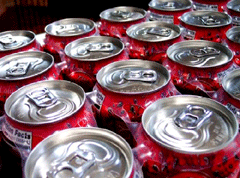
GELLERMAN: From the Jennifer and Ted Stanley studios in Somerville, Massachusetts, this is Living on Earth. I’m Bruce Gellerman.
CURWOOD: And I’m Steve Curwood.
On June 2nd the California Senate approved a measure that would ban the use of Bisphenol-A in baby bottles, sippy cups and food containers. If the measure becomes law, California would join Minnesota, the city of Chicago and Canada as jurisdictions that outlaw such uses of the chemical.
Bisphenol-A, or BPA for short, can disrupt hormones, and has been linked to diseases ranging from breast and prostate cancers to diabetes and heart disease, as well as developmental disorders.

While many efforts to ban uses of BPA have focused on baby bottles and other infant paraphenalia, a bill in the House would also keep it out of the inner lining of soda and food cans.
Recently, Washington Post reporter, Lyndsey Layton obtained the internal notes of a private meeting called by some manufacturers of cans for foods and beverages as well as some of their major customers. Ms. Layton reported that these executives brainstormed for hours about ways to assuage public concerns over Bisphenol-A., and she joins us now. Hi there.
LAYTON: Thanks for having me.
CURWOOD: So you heard that industry executives had this private meeting to help Bisphenol-A and its image. How did you hear about this and what happened exactly at this meeting?
LAYTON: Well I heard about the meeting through folks who are following this very carefully and I was able to obtain some internal notes that were put together by apparently one of the meeting participants. But it was a private meeting at a very exclusive private club in Washington. And these were largely members of the North American Metal Packaging Alliance. Those are the folks that make metal cans and metal packaging for food and beverages and some of their biggest clients like Coca Cola and Del Monte.

A recent study by the Harvard School of Public Health suggests BPA leaches out of plastic bottles into the people who drink water from them.
CURWOOD: Why is it that the packaging industry is so concerned about Bisphenol-A?
LAYTON: Well Bisphenol-A is a ubiquitous chemical. It’s found in thousands of consumer products. It’s largely used in plastics, but it’s also used in the epoxy linings of metal cans to prevent corrosion. And industry is very concerned because there is a movement afoot around the country to ban Bisphenol-A from food packaging. There are mounting concerns about health effects of this chemical and there’ve been a lot of studies that show Bisphenol-A leaches from plastics and from epoxy linings into food. And the food is consumed, of course, by us.
CURWOOD: Now, the Food and Drug Administration has been saying all along that actually Bisphenol-A is fine. You’ve covered the FDA for a long time. The Bush administration came under fire for a number of scientific questions in research. In fact there are allegations of cooking the science. How careful was the FDA about the question of BPA in the Bush administration?
LAYTON: Well the FDA based its decision that BPA was safe largely on two studies, both of them were funded by the chemical industry. And they have taken a lot of heat for that. There are now more than a hundred studies that were done by independent and academic scientists that link BPA to a range of adverse health effects, breast cancer, hyperactivity, obesity. And the FDA’s own scientific review board last year lambasted the agency for basing its findings on these two studies funded by industry.
CURWOOD: How is Congress responding to the growing controversy over Bisphenol- A?
LAYTON: Well there are several measures that are pending. Some of them want to get Bisphenol-A out of all baby products. One of them, this is Congressman Markey from Massachusetts, wants to get BPA out of all food and beverage packaging. And on June 3rd Peggy Margaret Hamburg, the new administrator of the Food and Drug Administration, the new commissioner, was on Capital Hill. She was answering questions about a separate piece of legislation and Congressman Markey asked her directly about BPA. And she said as a mother and as a physician, I am concerned about BPA and we are taking a new look, a fresh look at all of the scientific literature around this. And I’ve tapped our new chief scientist to review it and get back to me by the fall. Which is the first time that we’ve seen that from somebody in leadership at the FDA.
CURWOOD: Let me go back to this meeting for a moment. In your report in the Washington Post – it ran on Sunday May 31st – you list a number of tactics that they are discussing, that they are particularly concerned about the views of young mothers and that at this meeting they talk about how their holy grail spokesperson would be pregnant young mother who’d be willing to speak around the country about the benefits of Bisphenol-A. And you say that this is in the notes that you got.

While many efforts to ban uses of BPA have focused on baby bottles and other infant paraphenalia, a bill in the House would also keep it out of the inner lining of soda and food cans.
LAYTON: That’s right. They were talking about a response to all these various measures that are pending in state capitols around the country and on Capitol Hill and how they could try to get their message out. They also aired some frustration with the mainstream media, talking about how the mainstream media wasn’t listening to their side of the story, and how it would be great it they could present a young, pregnant woman who could be the spokesperson for the benefits of BPA.
CURWOOD: We had a chat with John Rost. He’s the chair of the North American Metal Packaging Alliance, the group that organized this meeting. He says your portrayal of what went down at that meeting is unfair and it’s based on a fraudulent document. How do you respond to that?
LAYTON: Well when I obtained the document, I contacted a woman named Kathleen Roberts. She is the executive director of the North American Metal Packaging Alliance. She’s also a lobbyist. And I emailed her the document that I had and I asked her to read it, and confirm its accuracy. And she did. She said that it wasn’t complete, that there were other issues that were addressed at the meeting, but the notes that I sent her she said were a reflection, an accurate reflection of some of the discussion that took place. And now John Rost is backpedaling and saying that these notes were fraudulent, they don’t know where they came from. And I can tell you that shortly after that the House Committee on Commerce and Energy, which is led by Henry Waxman sent a letter to John Rost asking him to turn over all documents, emails pertaining to this meeting. This committee has been looking into BPA and the way federal agencies have been regulating that chemical. And of course this is a committee with subpoena power. So it will be interesting to see what in fact the industry group does in response to that request.
CURWOOD: Lyndsey Layton is a staff writer for the Washington Post. Thank you so much Ms. Layton.
LAYTON: Well thanks so much for having me. It was fun to talk with you.
Related links:
- Click here to read Lindsey Layton’s story in the Washington Post.
- For more on links between BPA and cardiovascular disease, click here.
- For more on BPA in canned goods and human health, click here.
- Click here for the North American Metal Packaging Alliance’s views on bisphenol-A.
- For more on one of the more recent studies on BPA, finding it leaches from plastic bottles into humans, click here.
- Check out Living on Earth’s previous coverage of bisphenol-A here…
- … and here…
- … and here.
The End of the Road
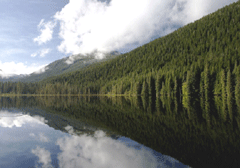
The Tongass National Forest.
GELLERMAN: For the last nine years, since the end of the Clinton administration, there’s been an ongoing battle over the building of roads in our National Forests. President Clinton banned most new roads in the pristine parts of the forest. President Bush then moved to repeal the ban and allow road construction, triggering court challenges.
Now the Obama administration is reviewing Mr. Bush’s action. And in the meantime it’s suspending any road building in the National Forests. Michael Anderson, a Senior Resources Analyst with the Wilderness Society in Seattle, says President Obama’s decision affects a huge part of the country.
ANDERSON: Nationwide it’s almost 58 million acres, about two and a half percent of all the land in the United States. And it covers 39 states.
GELLERMAN: A good chunk of this land is in Alaska, right?
ANDERSON: Yeah, Alaska has the most of the national forest roadless land.
GELLERMAN: So how would this affect that national forest land?

The Tongass National Forest.
ANDERSON: The protection will ensure that the magnificent temperate rainforests of the Tongass National Forest will not be logged within the roadless areas.
GELLERMAN: This is a very special forest, I understand.
ANDERSON: Oh yes, it has tremendous scenic values, fabulous salmon runs, it’s really probably the finest wild land that we have in the national forest system anywhere in the country.
GELLERMAN: You know this has been really a long and winding and bumpy road for this piece of regulation.
ANDERSON: That’s right. The Clinton administration went through a very extensive public process. It was I think the largest amount of public comment that had ever taken place on a federal rule making. 1.7 million people commented and over 90 percent were strongly in support of protecting the roadless areas. So the Bush administration came in with a very different perspective on national forests and the roadless areas. They suspended the Clinton administration’s policy from the very first day. Fortunately however, only seven miles of road were actually built during those eight years.
GELLERMAN: What’s the fear of building a road through a national forest? What’s the problem?
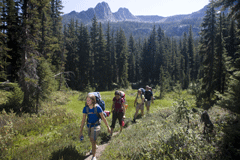
A family enjoys a hike in the Liberty Bell Roadless Area in the North Cascades of Washington state. (Courtesy of Holly Werran, of REI)
ANDERSON: Road building brings with it a lot of baggage, ecological baggage. For one thing, it causes erosion and harms the water quality of the streams. It hurts the fish habitat out in the northwest here, the Pacific salmon are able to spawn in these roadless areas in clean water and good quality habitat. And when you build a road in, you’re gonna often times lose that pristine quality of the water for the wildlife habitat and it reduces your opportunities for a nice hiking experience in the back country.
GELLERMAN: I know that some groups especially in the western part of the country say this is an issue of state rights, you know, we had California instituting cleaner air standards than the rest of the country and they asserted state rights issues. Is this not a states right question?
ANDERSON: Well if these were state forest lands, yes. But these are national forests, these are lands that are owned by all the American people, just like our national parks and national wildlife refuges. So it’s really not in the purview, we don’t think of state governors or state legislators to be dictating how the national forests or the national parks are going to be managed. It’s really a matter of the federal government and they should be answerable to all the American people, whether you’re in Chicago or New York. People care what happens up in the Tongass National Forest and the Idaho National Forest.
GELLERMAN: So we’re talking about national forest land here, right?
ANDERSON: Yes.
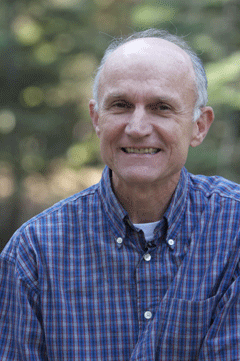
Michael Anderson is a lawyer for the Wilderness Society. (Courtesy of: John Waller)
GELLERMAN: And in the national forest there’s a much more strictly controlled part of land called “wildernesses” right?
ANDERSON: Yeah, those are lands that are designated by Congress under the Wilderness Act.
GELLERMAN: Well how if at all would this, you know, block on building roads affect wildernesses?
ANDERSON: It wouldn’t directly affect the wilderness areas within the national forest, but it does provide an opportunity for Congress in the future to designate additional wilderness areas because these will be areas that are kept basically in a pristine condition.
GELLERMAN: Well why just a one year, you know, block on building roads in national forests?
ANDERSON: Well this is an important first step for the Obama administration. They’re still getting their staffing together. This is a pretty tricky issue for the new administration and I think they’re just wanting to take things one step at a time, which I think makes perfect sense. There’s a lot that needs to be undone from what the Bush administration has tried to do with undoing protection of roadless areas. So it’s gonna take some time and a number of steps over the coming years.
GELLERMAN: Well Michael, thank you very much. I really appreciate it.
ANDERSON: You’re very welcome.
GELLERMAN: Michael Anderson is a Senior Resources Analyst with the Wilderness Society.
Related link:
The Wilderness Society
CURWOOD: Coming up: how a plan to protect the world’s tropical forests could put native people who live in them at risk. Keep listening to Living on Earth.
Tribal Representatives Speak out About UN Forest Proposal
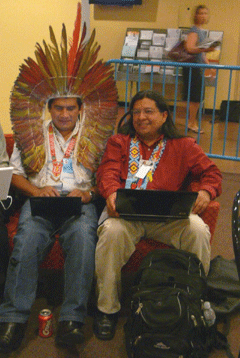
Egberto Tabo and Juan Carlos Jintach working in between REDD sessions. (Photo: Bruce Gellerman)
GELLERMAN: It’s Living on Earth, I’m Steve Curwood – and I’m Bruce Gellerman.
GELLERMAN: REDD…spelled R-E-D-D …. is the new green.
REDD stands for Reducing Emissions from Deforestation and Degradation. It’s a UN proposal to mitigate climate change by preserving the world’s tropical forests.
CURWOOD: Tropical trees store vast amounts of carbon - but each year wide swaths of forests are cut down or burned, releasing more greenhouse gases into the environment than all the world’s cars, planes, and trucks combined.
GELLERMAN: That’s where REDD comes in. The idea seems simple: the fastest way to reduce large scale emissions of CO2 is to protect forests, and the cheapest way to do that is to put a price on the trees so they’re more valuable left standing - preserving the carbon - than if they’re cut down.
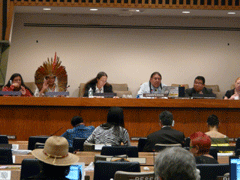
Tribal leaders meet at the United Nations. (Photo: Bruce Gellerman)
CURWOOD: Simple in principle, perhaps, but putting REDD into practice and making it part of the treaty this December at the UN climate negotiations in Copenhagen, will be difficult.
GELLERMAN: That’s because climate change is a hellishly complex issue - the devil is in the many REDD details that still have to be resolved. Janet Redman, of the environmental group Friends of the Earth, says one of the major problems is simply agreeing what is meant by: Reducing Emissions from Degradation and Deforestation.
REDMAN: There are so many different definitions of REDD. There’s no one legal definition at this point. There’s a definition from bilaterals, there’s a definition that international financial institutions have, there may be a UN definition soon, but at this point, we don’t even know what we’re talking about because there isn’t one concept that we’re all on the same page on.
[SOUNDS OF MEETING]
GELLERMAN: Forest protection was very much on the minds of delegates at the recent 8th UN Permanent Forum on Indigenous Issues, a ten day meeting held in a basement convention center at the United Nations building in New York City.
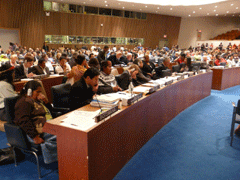
Indigenous representatives from more than 70 countries meet at the United Nations. (Photo: Bruce Gellerman)
[SOUNDS OF MEETING; SOMEONE COUGHING]
GELLERMAN: Hundreds of delegates from around the world gathered in a smoke-filled lobby, some wearing native clothes, feather headdresses, sarongs and animal skins, beads and hats, many hunched over laptops and held cell phones.
The place looked like a scene from Star Trek: a gathering of the global village. The talk was about avoiding deforestation and what that would mean for native peoples of the world...interpreters facilitated conversations but defining the REDD scheme can be culturally confounding says, Juan Carlos Jintiach of the Shuar tribe in Ecuador. Jintiach is Executive Co-director of Amazon Alliance, which represents more than a hundred rainforest organizations.
JINTIACH: If you bring this concept of REDD to the indigenous leaders they don’t know what you’re talking about. When we ask, what do you think about REDD - we’re talking this and this, so people say REDD is maybe red color or REDD may be something to do with fishing. So there’s no understanding this concept.
GELLERMAN: That’s not to say delegates at the Forum on Indigenous Issues didn’t realize what a REDD system could mean for them. Putting a price on carbon in trees to preserve the forest presents native people with a host of existential questions which they are largely powerless to answer. The Indigenous Forum is a high level body but it’s only advisory, so indigenous people have no real power at the United Nations climate talks, says Estabancio Castro Dias. He’s from Panama and the head of the International Alliance of Indigenous and Tribal Peoples of the Tropical Forests.
CASTRO DIAS: We believe that we haven’t been heard, because yes they give us a floor, but they give us a floor at the end of the day when all these delegates taking their papers and going out. So really it’s not taking into account what indigenous people saying and it’s not reflecting in the final paper of the negotiations.
GELLERMAN: Further complicating matters is a clash of cultures. The fundamental terms used to discuss REDD ---carbon trading – offsets and forest services, are alien concepts to many tribal and traditional people who speak of the Sacred Mother Earth.
Tom Goldtooth is head of the Minnesota-based Indigenous Environmental Network.
GOLDTOOTH: What’s happening is that in this whole market system is that it’s put a market value on traditional people and traditional teachings. Those things that we hold sacred to our people. This is evil at it’s worst. They’re trading air that is sacred. We’re looking at some spiritually profound values that people of industrial society really have a difficult time grasping. So when we talk about commodities – whether it’s the sacredness of trees, and especially air now – is in order to trade CO2, in order to trade greenhouse gases—this is air—is they have to define it as a property. It’s a property. Someone has to own the air in order to trade it. Very fundamental. So, the question is: who owns the air then?
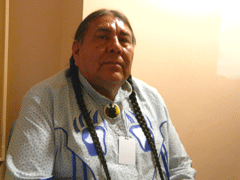
Tom Goldtooth is head of the Indigenous Environmental Network. (Photo: Bruce Gellerman)
GELLERMAN: And who owns the forests? And who gets the money that’s paid to preserve trees? Under a plan to pay to protect tropical forests ---billions –perhaps even trillions of dollars in carbon credits will be bought and sold. International lending organizations like the World Bank are playing a major role in developing the REDD mechanism.
[SOUNDS OF A PROTEST, CHANTING IN SPANISH]
But indigenous leaders denounced the organization’s human rights record. And during the UN Indigenous Forum protestors marched on Peru’s Consulate General.
[SOUNDS OF A PROTEST, CHANTING IN SPANISH]
GELLERMAN: The Peruvian government recently passed a law making it easier to buy land in the Amazon, land indigenous people of the forest say is theirs. Tribal members blocked oil pipelines, rivers and highways, demanding the law be changed. Peru’s president declared a state of emergency.
[TABU SPEAKING IN SPANISH]
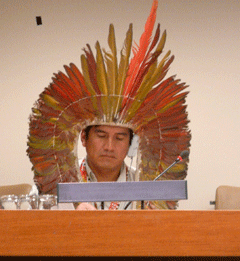
Egberto Tabo, president of the Coordination of Indigenous Organizations of the Cuenca Amazonia (COICA), leads a discussion at the United Nations. (Photo: Bruce Gellerman)
GELLERMAN: Egberto Tabu of Peru led the protest. He’s head of the Amazon Basin Indigenous People’s Organization. Tabu says he’s profoundly concerned about the proposed REDD forest plan because it threatens the indigenous peoples’ rights. As the market price for forests increases he warns, there will be a land grab - a green gold rush for the rights to possess the carbon locked in tropical trees.
[TABU SPEAKING SPANISH]
VOICEOVER: REDD is only made for corporations. We’re the landowners. We’re worried abut REDD. It’s not fair. We are the ones living in the jungle. We haven’t been taken into account in the design of REDD. Again, we will be the victims of the violation of the rights of indigenous people.
GELLERMAN: Two years ago, after two decades of debate, the United Nations Declaration on the Rights of Indigenous Peoples was adopted by 143 countries. The U.S. was one of just 4 nations that rejected it. Australia – another of the hold-outs - has since announced it will endorse the Declaration.
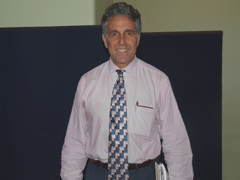
Charles McNeil from the United Nations Development Program. (Photo: Bruce Gellerman)
AND Charles McNeill from the UN Development Program says while the REDD forest deal may be flawed, slowly, things are changing.
MCNEILL: It’s true that they are not sitting around the table with governments in the UN Framework Convention on Climate Change; but what is encouraging is that the voice and impact and influence, I would say, of indigenous people has grown tremendously. It’s one of the most encouraging things I’ve seen, that every government, every donor, every NGO, every foundation working in this space is at least alluding to, referring to, talking the talk in terms of indigenous issues. Now, the issue is walking the talk and that’s where we’re about to embark ourselves.
GELLERMAN: In March, the UN body coordinating REDD negotiations granted indigenous people a voting seat on their panel where decision making is by consensus. Charles McNeill says despite the many challenges, a REDD method for preventing deforestation is the only way to rapidly stabilize global greenhouse gas emissions.

Egberto Tabo and Juan Carlos Jintach working in between REDD sessions. (Photo: Bruce Gellerman)
MCNEILL: If REDD weren’t so important I would have nothing to do with it because it’s so complex technically, politically, economically socially. But the only way out is through and to deal with REDD you’re going to have to deal with governance, you’re going to have to deal with poverty, you’re going to have to deal with human rights, equity, all the issues have to come to the fore to get this to work. As I say, it’s the most difficult challenging thing on Earth to be working on, and yet we can’t avoid it.
GELLERMAN: Indigenous leaders say industrial nations caused the climate crisis and before they’ll promise to go along with a REDD forest preservation scheme, developed countries will have to make deeper cuts in their greenhouse gas emissions.
But even if they do, Tom Goldtooth, Executive Director of U.S.-based Indigenous Environmental Network fears Reduction of Emissions from Deforestation and Degradation will turn native peoples into renters of their own land. Yet, he also believes climate change is real, and as icecaps melt and the oceans rise, we have only one option.
GOLDTOOTH: We’re in this dilemma as indigenous peoples but we’re not alone, we shouldn’t be alone in this. We have to stand together with all human beings, all two- legged people, because we’re in the boat together.
[MUSIC]
CURWOOD: For more information about forests and climate change and pictures of the UN Permanent Forum on Indigenous Issues, check out our web page: loe.org
[MUSIC]
Related links:
- United Nations Permanent Forum on Indigenous Issues
- International Alliance of Indigenous and Tribal Peoples of Tropical Forests
- Indigenous Environmental Network
- Coordinator of the Indigenous Organizations of the Amazonian River Basin
Growing Hope in New Orleans
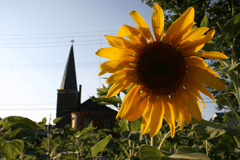
(Courtesy of Will Bradshaw)
CURWOOD: It’s hard not to smile at a field full of radiant sunflowers, and that’s one reason why a redevelopment group in New Orleans is planting the giant blossoms in vacant lots, a bid to reclaim a badly blighted neighborhood near the superdome.
Not only will the sunflowers brighten people’s lives, they’ll also help power cars and trucks. Will Bradshaw is president of Green Coast Enterprises in New Orleans, and a partner in Project Sprout, which is based on a similar program at Pittsburgh. Welcome to Living on Earth, Mr. Bradshaw!
BRADSHAW: Hi.
CURWOOD: So I understand that you just recently planted your first test plot of sunflowers in New Orleans. Tell me about the area where you’re starting. How big is it? Where is it located?
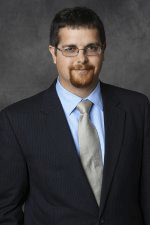
Will Bradshaw is president of Green Coast Enterprises. (Courtesy of Will Bradshaw)
BRADSHAW: It is three of the four corners of the intersection of Jackson and Johnson, which is right adjacent to the B.W. Cooper housing project.
CURWOOD: So what did these lots look like before you started planting the sunflower crop?
BRADSHAW: They were largely overgrown. One of them had been filled with construction debris from what looked like a foundation excavation. So it had some pieces of concrete and rebar and a bunch of piles of dirt. And then grass and weeds and whatnot had grown over the top of that. Another had been used by a road crew illegally to store their materials, including some potentially contaminating product for curing concrete in a big 55-gallon drum that was just open. Another had an old boat that had been basically rotted in half and been left there and some tires and stuff like that. But they were all largely abandoned lots that had just been used for illegal dumping.
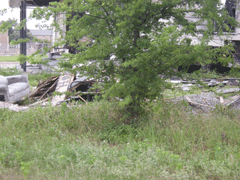
Trash and construction debris is illegally dumped on empty lots. (Courtesy of Will Bradshaw)
CURWOOD: I understand that sunflowers can actually take toxins out of the soil.
BRADSHAW: There’s no question that sunflowers make soils better with respect to the level of heavy metals. What is debated about it is how much better and how quickly the things get better. There has been some research here in New Orleans out of the Center for Bioenvironmental Research at Tulane and Xavier that shows that because the pH levels in most of the soils in New Orleans, that the uptake of heavy metals is significantly delayed. And Howard Mielke in particular has done some research that shows it may take as much as a thousand years to actually clean a heavily contaminated plot in New Orleans. But there’s also some competing research that comes out of Dillard University that has shown that in a couple of growing seasons a lot in Central City moved from being unsafe according to EPA standards to a safe level for alternative uses.
CURWOOD: So let me understand this – once the plants take out some toxins from the soil, are the sunflowers themselves contaminated?
BRADSHAW: Most of the contamination is held in the stalk, and if you are planting sunflowers in a lot that has high levels of lead, then you need to treat the stalks as a biohazard.
CURWOOD: So, I understand you actually plan to make biodiesel from the sunflower seeds. Can you tell me about that?
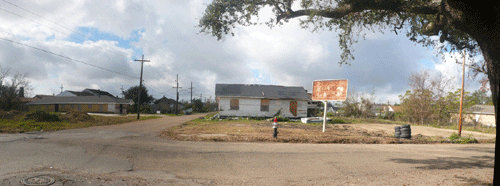
The pilot plot in New Orleans before sunflowers are planted. (Courtesy of Will Bradshaw)
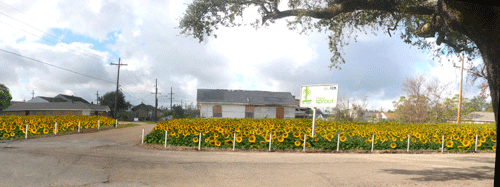
An artist's rendition of what the test plot will look like after the sunflowers grow to maturity. (Courtesy of Will Bradshaw)
BRADSHAW: Yeah, we’ll harvest the flowers themselves and extract the seeds and the seeds are actually where the oil is. And we’ll press the seeds and then that will create some oil that can be used with recycled vegetable oil. We won’t make very much. These lots will probably produce somewhere between 20 and 50 gallons – maybe a gas tank – but what we will be able to do is work with someone else who is processing or reprocessing used vegetable oil, and the virgin oils actually can be mixed with used vegetable oil to improve the quality of the recycled grease.
CURWOOD: Well you could have planted many different crops that can be converted in to some form of biofuels. We pick sunflowers? Why not sugar cane – they grow a lot of that in Louisiana. You could make ethanol. Or corn.
BRADSHAW: One of the most important things about Project Sprout is that sunflowers really create hope. People have a direct connection to them. Most people have a sunflower story – you know, their grandmother used to plant sunflowers in her yard, that they used to harvest them at home when they were growing up. There’s this real connection that people have with them that signals a brighter future than what people see for that space now.
CURWOOD: So you’re starting out pretty small in New Orleans, but what are your plans for the future? In a decade from now, to what extent should we expect to see the Big Easy just covered in sunflowers?

Project Sprout has already had success converting brown fields into fields of sunflowers. (Courtesy of Will Bradshaw)
BRADSHAW: Hopefully a decade from now what you’ll see is lots that were covered in sunflowers. You know, it’s a little bit of an interesting model in the sense that we don’t actually want to be over the long term, planting things all over the place. What we would like to be doing is targeted planting in neighborhoods that suffer from these significant blight problems at a large scale. And we think that that would really create a significant turning point for that place. And then you start to sort of stabilize that neighborhood and allow for other uses to come it.
CURWOOD: Will Bradshaw is president of Green Coast Enterprises in New Orleans, Louisiana. Thank you so much, Will.
BRADSHAW: Thank you.
Related links:
- Green Coast Enterprises
- GTECH Strategies
Everybody Eats
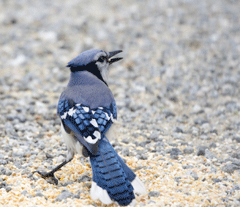
(Photo: Mark Seth Lender ©)
GELLERMAN: When writer Mark Seth Lender began feeding birds, he had no idea how demanding his feathered customers were going to be.
LENDER: These late Spring days when first light comes so early even the bedroom windows blink and squint, all I want to do is pull the covers over my head. That’s when the birds begin, drumming me to breakfast. It is not an invitation to eat. It’s an invitation to cook. For them. I’m the one who has not had his coffee and they are the ones who are grumpy. “Come and get it” is all they want to hear, finest spread North of the Border, this diner opens when the customers order.
“Whiskey dry!” I put the breadcrumbs out.
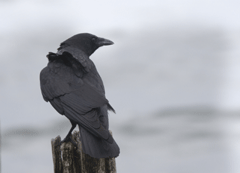
(Photo: Mark Seth Lender ©)
“Birdseed hold the Baby!” bowlfuls of safflower & sunflower straight from the box, this client needs no milk on their breakfast cereal.
First to arrive, it’s always the cardinals. They grab and run as if they have a schedule and a clock to punch. Next the white-breasted nuthatch. Not a regular. Used to dine at the tree across the street but he’s comin’ ‘round. Spying his meal with just one eye, he’d turn his bill to the side, awkward and slow. After a week he’s learned the common technique, barely parted beak dainty as chopsticks, very neat. Next in line, dark-eyed juncos and a whole gang of tree sparrows. ground feeders, they are accustomed now to the narrow counter of the porch rail, though they scrape and scratch their feet to get at what they want. Food everywhere!
“Hey! Ya gonna be a slob? Go take ya picnic somewheres else.”
But it’s okay, the mourning doves jump on what the juncos leave behind and clean up every scrap.
“Sharp-shinned hawk!” The bluejay cries. Birds dive for the bushes like the joint’s been raided and whisper when they talk, thin high whistles of warning. Some are always caught, feathers settling on the front walk. The mourning doves truly have a thing to mourn this morning.

(Photo: Mark Seth Lender ©)
Rain. The place empties out. I get to sit, looking forward to a quiet second shift when, in a New York Minute, pandemonium – everybody starvin’ all at once!
“86 that Cup a Mud ta go, Crow don’t want it anyways. Bottled water? We got City Juice, take it or leave it!”
By the end of the day all I’ve earned is dirty dishes, and just when it’s time to kill the lights, the cardinals dash in for one last bite before I pull the mat up for the night.
But the proprietor – that’s me - knows business is business, it all adds up, I take in all the custom I can. Even that pesky gray squirrel rates a Blue Plate Special.
Everybody eats when they come to my house.
GELLERMAN: Mark Seth Lender writes the syndicated column “Salt Marsh Diary.” To see some of his photographs and find out more about his writings, go to our website at LOE.org.
Related links:
- Salt Marsh Diary
- Click here for Mark Lender’s glossary of diner slang.
Just ahead – I am the walrus – and I can sing.
CURWOOD: Goo goo g’joob.
Stay with us on Living on Earth.
Discovering Walruses
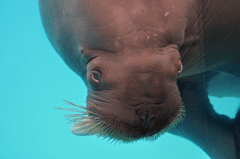
Sivuqaq the walrus might not look like the musical type, but his trainers know better. (Photo: Nancy Chan, Six Flags Discovery Kingdom)
GELLERMAN: It’s Living on Earth. I’m Bruce Gellerman.
CURWOOD: And I’m Steve Curwood.
The walrus is one the world’s most mysterious mammals. Its habitat is far from humans and very inhospitable for researchers. Much of what scientists do know about them comes from the native peoples who hunt them.
One very little known fact is that walruses are musical -- their songs are some of the longest and most complex in the animal kingdom. Now climate change is adding urgency to walrus research.
In Vallejo, California, researchers are hoping they can discover the secrets of walrus breeding songs and use that knowledge to help preserve the species. Matthew Brunwasser reports – and a warning – his report frankly refers to walrus reproduction, using scientific language.
[WALRUS ROAR]
BRUNWASSER: Now is a trying time to work at the walrus tank at the Six Flags theme park. Trainer Toni Rael introduces me to Sivuqaq, a 2400 pound male pacific walrus who lives here. He’s about the size of a Honda Civic. Rael says he is being obnoxious, like a guy in a bar.
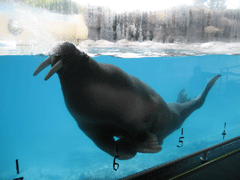
Sivuqaq in his tank. (Photo: Matthew Brunwasser)
RAEL: Well Sivuqaq thinks it breeding season. So right now, he is in his rut, male walruses go thru a rut behavior where they will make a lot of different vocals to solicit females and try to get the girls’ attention. However, the females have already been through their cycle and are no longer in season, so they’re done with him. [laughs]
[WALRUS ROAR]
RAEL: So now he’s soliciting everyone he can find. [laughs]
BRUNWASSER: The park is trying to breed Sivuqaq its two female walruses. But no luck so far. Rael says they haven't quite figured out how to get him in the mood at the same time as the females. He also seems a bit confused.
RAEL: Strange things at different times seem to get him excited. He seems to like anything at the lower windows. We have had a new recycle bin that we put at the window; he really liked that for awhile. Anything different, strollers, people, anything power-tool related.
[SPLASHING SOUND; WALRUS ROAR]
BRUNWASSER: Sivuqaq and the two females came to the park when they were only a few months old, after being orphaned in a hunt in Alaska. All are unrelated. And none grew up with adult walruses. So their behavior is an ad hoc mix of instinct and learning in captivity. Holley Muraco is a reproductive physiologist researching walruses at the park. She says little is known about walrus breeding in general.
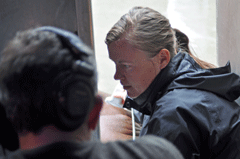
Holley Muraco does ultrasound on a female walruses, checking her ovaries. (Nancy Chan, Six Flags Discovery Kingdom)
MURACO: There’s only ten walrus calves ever born in zoological facilities, so that's pretty significant. They are very sexual animals, they live long lives in zoos, but for some reason we not getting a lot of babies. So clearly something is missing.
BRUNWASSER: Muraco says weather, temperature and sunlight could be factors, since the Bay Area is mild year-round. She is also checking hormones, and monitoring body fluids regularly, in both Sivuqaq and the females, to find the triggers for their breeding behavior. She says she wants to collect the first walrus sperm sample ever taken. A healthy batch would be valuable for study and could also be used to artificially inseminate one of the females. She holds up a special tube-shaped instrument.
MURACO: This is the artificial vagina, and it's basically a PVC pipe. It has got thick rubber on either end of it, so that there’s no sharp edges. We will train him to put his penis inside there and hopefully we will figure out what exactly the trigger is that’s going to make him feel comfortable enough to give us a sample.

Reproductive physiologist Holley Muraco, with the artificial walrus vagina. It has a handle and a valve so it can be filled with warm water. (Photo: Matthew Brunwasser)
BRUNWASSER: The park will then build a mount for the artificial vagina and hope that Sivuqaq takes a liking to it. There are still many surprises when you are dealing with walrus sexuality. The walrus, like many mammals, has a baculum, or penile bone. Researchers say it's an impressive sight.
MURACO: It's about three feet long. The native people use the walrus penis bone as walking sticks, they use them as clubs, in the past. And it’s a pretty remarkable, definitely a pretty remarkable structure.
[WALRUS ROAR]
BRUNWASSER: Another extraordinary attribute of male walrus behavior is their musicality. Through a viewing window, research biologist Colleen Reichmuth is observing and filming Sivuqaq’s displays and vocalizations underwater.
REICHMUTH: Three, two, one, go
[KNOCKING SOUNDS]
REICHMUTH: This is Sivuqaq track number three. He’s at two and a half meters, head up, filling the sacks, producing some bell-like sounds, moans at two and a half, double knock, some low amplitude moans.
BRUNWASSER: Reichmuth is gauging the strength of Sivuqaq’s sounds.
[WALRUS MOANS]
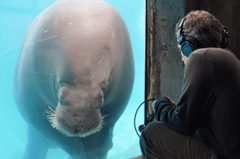
Reporter Matthew Brunwasser records Sivuqaq. (Photo: Nancy Chan, Six Flags Discovery Kingdom)
BRUNWASSER: He claps his flippers in the water as part of his display. You can hear it loudly even through the 4-inch thick window of the tank. Here it’s also amplified through a speaker.
REICHMUTH: You know, walruses are some of the most amazing animal in terms of their acoustics because they can make sounds with all different parts of their body.
BRUNWASSER: Walruses are piniped beatboxes, clapping, moaning, whistling and making bell sounds with an air sack in their necks.
REICHMUTH: An important sound we that should hear today is called the knock. It’s a really loud knocking noise he is making inside his forehead without releasing any air. And we’re not really sure how he is manipulating his anatomical structures to make such a loud noise.
[WALRUS KNOCKING]
BRUNWASSER: To try to find out, Reichmuth rejoins Sivuqaq face to face upstairs. Leah Coombs is a master walrus trainer, has been with Sivuqaq since he was a baby.
[WALRUS KNOCKING]
COOMBS: Knock, knock, good.
[WALRUS KNOCKING]

Sivuqaq the walrus might not look like the musical type, but his trainers know better. (Photo: Nancy Chan, Six Flags Discovery Kingdom)
BRUNWASSER: Reichmuth puts her hand into his mouth to try to feel where the sounds are coming from. The display is followed by a surprise blown from his nose.
[THE SOUND OF A WALRUS EXPELLING SNOT]
COOMBS: What is that?!
[LAUGHTER]
BRUNWASSER: Sivuqaq is clearly still learning to sing. In the wild, the knocks of male walruses are far more developed.
[WALRUS KNOCKING]
BRUNWASSER: This might sound like a German industrial band from the 1980s. But this is a wild walrus, recorded in the Canadian high arctic. Underwater. The sounds are so loud and sharp they can be heard above the sea ice and underwater more than 5 miles away.
[WALRUS KNOCKING]
BRUNWASSER: This medley of breeding sounds includes knocks and bells.
[WALRUS KNOCKS AND BELLS]
BRUNWASSER: Scientists can only hope they figure out these mustachioed enigmas quickly enough to keep up with the pace of arctic climate change. Joel Garlic-Miller is a walrus biologist at the U.S. Fish and Wildlife Service in Anchorage. He says a warming Arctic is bad news for walruses because they prefer to live on floating sea ice.
GARLIC-MILLER: If you look at long-term data sets of sea-ice thickness and extent, we’ve seen some very substantial declines in both the area covered by sea ice and sea ice thickness over the past 20 years.
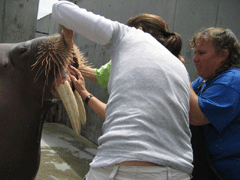
Reichmuth tries to feel where the knocking comes from in Sivuqaq’s head by putting her hand in his mouth.
BRUNWASSER: When the sea ice disappeared in the summer of 2007, thousands of walruses hauled up on the Alaska coast for the first time. The skittish animals have no experience with people, cars or airplanes, and are prone to stampeding and trampling which can kill juveniles. Wild walruses are almost never seen by humans, unlike polar bears which live close enough to people to eat from their garbage cans. Garlic-Miller says no one has ever been able to count how many walruses there are.
GARLIC-MILLER: They inhabit a vast, remote inaccessible habitat. Probably the most remote area on the planet and most difficult to access. Shifting sea ice, over thousands and thousands of square miles, many hundreds of miles offshore is where they prefer to distribute themselves.
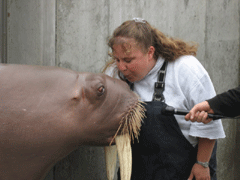
Walruses like it when you blow in their nose; this is how they “meet” each other. (Photo: Nancy Chan, Six Flags Discovery Kingdom)
BRUNWASSER: So U.S. and Russian scientists began the first serious population survey of the Pacific walrus in 2006. The findings should be ready soon.
GARLIC-MILLER: It's been quite a challenge to get some very basic biology about them.
BRUNWASSER: Walruses are not currently listed as threatened or endangered. But due to diminishing sea ice, U.S. Fish and Wildlife was petitioned last year to consider listing them. A decision is expected in the fall of 2010.
For Living on Earth, I’m Matthew Brunwasser, in Vallejo, California.
Cycling to the Bottom of the World
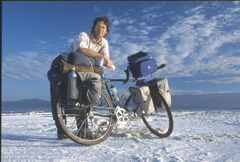
Malusa at Lac Assal, Djibouti- the lowest point in Africa. (Courtesy of Jim Malusa)
GELLERMAN: Many mountaineers aspire to climb the highest peaks on Earth. For Jim Malusa, it's a race to the bottom.
In 1996, Malusa, a botanist, hit the road on his bike seeking the lowest points on the planet. He started in Australia and it's been downhill ever since. Over the next six years he pedaled to Death Valley, the Dead Sea, and the depths in between.
Jim Malusa chronicles his adventures in his book “Into Thick Air: Biking to the Bellybutton of Six Continents.” Jim, welcome to Living on Earth!
MALUSA: Hello. I’m glad to be here.
GELLERMAN: Why the bellybutton?
MALUSA: Well, I began with a map that my wife and I found in the “Times Atlas of the World.” There was a place on that map in western China that had green spots. And it was called Turpan. And looking closer we discovered it was 500 feet below sea level. We wondered what was going on down there, and chose a route, and went through the mountains of Central Asia, Kyrgyzstan and Kazakhstan and it ends up that it was very cold. And we got very hungry on the way. And by the time we got to Turpan, it was an absolute delight to find it filled with watermelons and grapes and friendly folks. And it wasn’t too hard to think, the pits aren’t so bad after all.
GELLERMAN: Are you the only person who has ever traveled by bike to the lowest places on the planet?
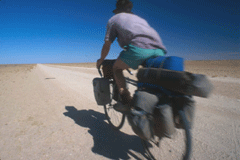
Malusa biking across Australia. (Courtesy of Jim Malusa)
MALUSA: I think I’m the only person who’s ever been there by any means of transport. You know the seven summits resulted in a race to the top, but no one’s really interested in going down. You know, you don’t go to make a record with these sort of things. You just go to see.
GELLERMAN: I knew that the Dead Sea was the lowest point on the planet, but I didn’t realize that was a lowest point by a lot compared to the other places, what is it – 1350 feet, is that right?
MALUSA: No, you’re right. Second place is far, far behind. It would be as if Mount Everest had 29,000 feet and then second place would be a mere you know 12,000 feet or so. The second lowest point is in Djibouti, and Turpan actually at around 500 feet below sea level. So the Dead Sea is almost three times as deep. The Caspian Sea is 92 feet below sea level, the shoreline, Salina Grande is about 140 feet, Death Valley 282 feet below sea level, Lake Eyre, Australia is about, oh, 49 feet below sea level.
GELLERMAN: You’re a guy who likes to have a beer, a cold one. But along your way you kind of indulge in local brew. You had what – yerba mate.
MALUSA: Yes, in Patagonia. In South America its mate they drink. I found it a little bit astringent, but I do like the way they tend to share it sometimes. They have a communal mate. The mate’s actually the gourd that you drink it out of. The yerba mate is the tea itself. And I tell the story of my first taste, the real surprise of course was not the taste, but discovering that the man who offered it to me, had given me a bull testicle to drink it from.
[LAUGHING]
MALUSA: He insisted that it’s always better with the testicle.
GELLERMAN: Well, I can’t attest to that but [laughing] I’ll take his word for it. [laughing]
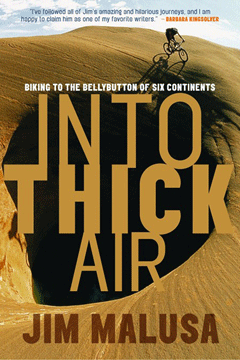
GELLERMAN: You also took somebody’s word that Salina Grande which is where you took your bike was the lowest place in South America … and it wasn’t!
MALUSA: What a surprise that was. At that time the Argentina Institute of Statistics, it was understood to be the low point. Patagonia’s a big place, and in the last ten years, they’ve discovered a place that was lower. After some initial dismay and saying “Oh my Lord, I’ve pedaled to the wrong low point” now I have a reason to return.
GELLERMAN: When you were planning your trip to Djibouti, people weren’t very positive about your going. Who was it L.M. Nezbit called it The Hell Hole of Creation?
MALUSA: Every tail from Djibouti from earlier in the 1900s has a horrible name like that -The Hell Hole of Creation – and the people developed quite an unsavory reputation simply because of a little habit they had of castrating their enemies. And this is carried over well past the time where this has gone on. And the reputation persists. And so I was, I suppose the right word would be terrified at first, and then I became less terrified the more I learned. And once I started talking with people that had been to Djibouti, a particular Swiss photographer who told me well, you know, don’t worry about that castrators, that’s rubbish, there’s occasional knife fights and stabbings, but it’s not nearly as bad as Detroit, he insisted. And then I called the Djiboutian embassy themselves, and they said, well, do you have bicycle experience? And I said yes, I just rode my bike across Russia. And they said what about the security in Russia? Isn’t it dangerous? So people tend to believe that it’s always more dangerous elsewhere.
GELLERMAN: Another local delicacy you indulge in is in Djibouti. You were chewing khat. It’s a plant that locals prize as much as the Argentineans praise mate.
MALUSA: Yes, when I was preparing to go to Djibouti, after I convinced the embassy that the security in Russia really wasn’t that bad, they said “well, don’t worry about Djibouti at all, because in the afternoon we’ll be chewing the khat. They said it’s a stimulus something like coffee and we only chew it from maybe one o’clock to around seven.

Malusa at Lac Assal, Djibouti- the lowest point in Africa. (Courtesy of Jim Malusa)
[LAUGHING]
MALUSA: And they said, you won’t feel any stress. And I do like it. It is just what they say – it’s a mild stimulant. And the reason that I think its popularity is restricted to the Horn of African region and also the Saudi peninsula is not only because it’s a class one offense or something by our own drug association but because the chemicals that make it such a happy chew almost immediately decompose into more useless things. And so it has to be chewed within – essentially within a day. So, in Djibouti, a country which is hardly on the cutting edge of technology. It’s the kind of country where you spend a lot of time waiting for things to happen. It’s something of a miracle to watch khat delivery, which would make FedEx envious. It comes exactly on time, every day, by jet, and then it’s delivered by speedboats racing around the country along the coast. And it’s quite an organization they’ve got set up.
GELLERMAN: Well, Jim, where’s your next ride taking you?
MALUSA: When I left Patagonia, I swore I’d never go back because of all the places in the world I went that was the most rugged in terms of the weather. In the Andes the wind and the rain, in the desert the wind. Now that I’m talking about it, I know I’m not gonna do it. But perhaps some day I’ll get my nerve up and return.
GELLERMAN: Yeah, you’re making it sound mighty miserable.
MALUSA: Well bicycles can be miserable sometimes. Most of the time they’re not. I’d like to think of them as – they intensify life. They make good times better, and they make bad times worse. You have to accept that if you’re gonna go out. When the conditions are good, boy do you feel good. But when things get bad you can be stuck for a while too.
GELLERMAN: Well Jim thank you very much. I really appreciate you taking the time for us.
MALUSA: Thanks for having me.
GELLERMAN: Jim Malusa’s new book is called “Into Thick Air: Biking to the Belly Button of Six Continents”
[BICYCLE BELL]
Related link:
Check out Jim Malusa’s website.
GELLERMAN: On the next Living on Earth, forest economics are changing along with the climate. Some forest owners now spare the big strong trees and send only the smaller ones to the mill.
MAN: Ironically, by us going in and selecting out slow-growing, weaker trees, and creating space for the more vigorous trees to grow, we’re increasing the rate of carbon sequestration in the forest.
GELLERMAN: And that carbon sequestration’s worth money as well. Forest green, next time, on Living on Earth.
[STREAM SOUNDS]
GELLERMAN: We leave you this week on a June day at a meadow stream.
GELLERMAN: This recording of Lincoln Meadow in the Sierra Nevada Mountains of California was made in 1989 by Bernie Krause of wildsanctuary dot com.
CURWOOD: But the enchanted landscape is no more. A year or so later, the trees in the region were completely clear-cut and the meadow has not recovered. First, the sounds from 1989. Then compare it with the recording of the same meadow in 2007.
[MOSTLY SILENCE, SOME WHITE NOISE]
CURWODO: Living on Earth is produced by the World Media Foundation. Our crew includes Bobby Bascomb, Eileen Bolinsky, Ingrid Lobet, Helen Palmer, Ike Sriskandarajah, Mitra Taj, and Jeff Young with help from Sarah Calkins, Marilyn Govoni, Sammy Souza and Marcos Rodriguez.
GELLERMAN: Our interns are Annie Glausser and Lisa Song. Jeff Turton is our technical director. Alison Lirish Dean composed our themes. You can find us anytime at loe.org.
I’m Bruce Gellerman.
CURWOOD: And I’m Steve Curwood. Thanks for listening.
Living on Earth wants to hear from you!
Living on Earth
62 Calef Highway, Suite 212
Lee, NH 03861
Telephone: 617-287-4121
E-mail: comments@loe.org
Newsletter [Click here]
Donate to Living on Earth!
Living on Earth is an independent media program and relies entirely on contributions from listeners and institutions supporting public service. Please donate now to preserve an independent environmental voice.
NewsletterLiving on Earth offers a weekly delivery of the show's rundown to your mailbox. Sign up for our newsletter today!
 Sailors For The Sea: Be the change you want to sea.
Sailors For The Sea: Be the change you want to sea.
 The Grantham Foundation for the Protection of the Environment: Committed to protecting and improving the health of the global environment.
The Grantham Foundation for the Protection of the Environment: Committed to protecting and improving the health of the global environment.
 Contribute to Living on Earth and receive, as our gift to you, an archival print of one of Mark Seth Lender's extraordinary wildlife photographs. Follow the link to see Mark's current collection of photographs.
Contribute to Living on Earth and receive, as our gift to you, an archival print of one of Mark Seth Lender's extraordinary wildlife photographs. Follow the link to see Mark's current collection of photographs.
 Buy a signed copy of Mark Seth Lender's book Smeagull the Seagull & support Living on Earth
Buy a signed copy of Mark Seth Lender's book Smeagull the Seagull & support Living on Earth

